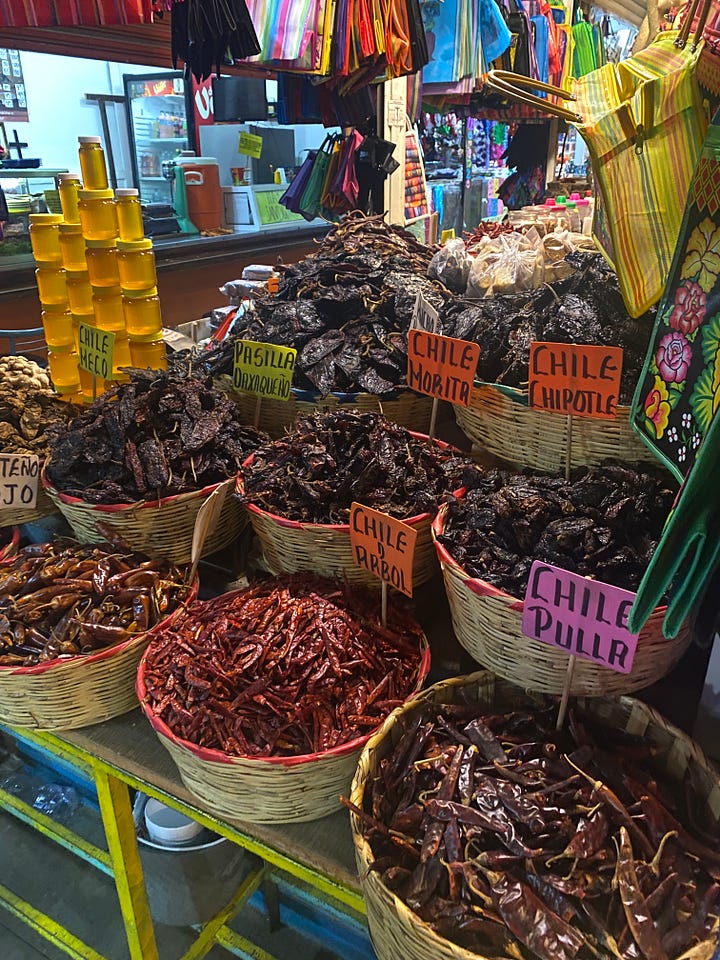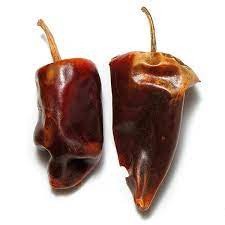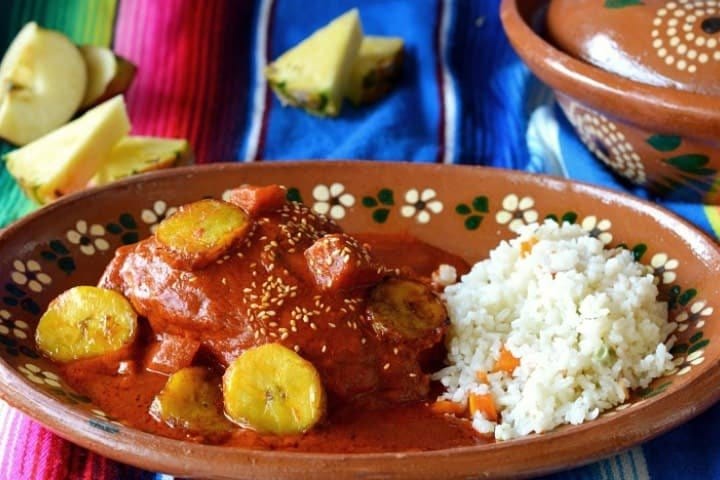Exploring more of Oaxaca food culture & ingredients.
I’m not sure how you can separate interest in cooking from food cultures. Especially when traveling you see first hand how food and agriculture influence a culture heavily, which I find intriguing and fascinating
In Oaxaca, Corn 🌽 & Chilis 🌶 are of great importance as local crops, ingredients for cuisine and exports.
Oaxacan Corn
In Oaxaca the different types of corn literally span the colors of the rainbow.
Red, yellow, green, blue, purple and white. You name it, Oaxaca’s got it



This corn is rarely used “fresh”. Instead it is dried then used for making masa, tamals 🫔, tamales, tortillas and even used as a thickener in certain molés
Note: peasant ‘everyday’ molés used masa as an economic thickener since it was plentiful, whereas celebratory special molés use bread as a thickener which was more of a luxury item back in the day. More on molé later
Back to corn 🌽
What ancient people long ago discovered is that the outer husk of the corn kernel isn’t digestible.
To fix this problem, it was discovered that soaking corn in a water bath containing lye converted the entire corn into something digestible that is also super tasty.
This process is called nixtimalization.
Won’t go into the exact reaction and process, just remember:
undigestible corn 🌽 ➡️ nixtimalize ➡️ now tasty and delicious corn 🌮
So now we’ve got tasty digestible corn kernels… now what?
We grind
Molino
Enter the molino. My chef friend in Oaxaca calls the Molino the secret ingredient of every good restaurant and home kitchen in Oaxaca. These are focal points of the community.
A molino has multiple grinding machines, each with stone plates that grind primarily: corn into masa, chilis into molé pastes and cacao into chocolate, rice into horchata.
Yup, 3 of Oaxacas most famous preparations all produced and ground at the molino.






Because the stones are porous, each grinder has a dedicated function. You don’t want your horchata to smell like chili, for example.
Back in the day, grandmas would use a mano and metate to grind but with the modernization and efficiency, the molino has been a huge time saver though some grandmas still make their molés, etc the OG way.



Important to note here that you’re probably thinking “ok my blender at home will work”. You can for molé but it will never taste the same. You have to add liquid to not burn out the blender motor and the blade action doesn’t give you as a complex a flavor profile as stone grinding. Same way a curry paste pounded in a mortar and pestle tastes better than one thrown in a blender.
Masa
Chances are you’ve had powdered masa. You’ve probably seen bags of Masa Harina on the flour and baking aisle of your local grocery store.
To be clear though, the flavor differences between fresh masa and masa harina are worlds apart.
This makes a trip to Oaxaca worth it, just to experience fresh masa.
Some larger cities, and locations with large Mexican populations, in the US now have molinos that you can find fresh masa which is a great cheat code.
Important to note though, if the molino is using crappy corn, the masa will tell the story. There’s nothing to hide behind. It’s just corn 🌽 , quality matters.
Back to masa in Oaxaca
One thing I noticed was that tortillas in Oaxaca seemed much thinner than versions I’ve had in Mexico City, etc.
An older lady I cooked with told me that is by design since the tortillas in Oaxaca are traditionally used to soak up molé sauces. They don’t need to thicker structure required for holding a full taco together. I found this really interesting and when making tortillas with her I was required to do 2 presses for each tortilla.


As far as tamales 🫔, I was told that Oaxaca has the fluffiest, softest tamales because they use a masa that is more coarse vs what is used for tortilla. You can see in the pics below. The masa in the metal bowl is more coarse. It is then mixed with lard by hand for approx 10 mins use a scooping motion until it forms a loose paste (pictured in the bowl with two metal spoons).
This was without a doubt the best tamale I’ve tasted in my life. The masa mixture with some shredded pork and a quick salsa verde. Steamed to perfection. My eyes rolled back in my head.





Oaxaca Chilis 🌶
There are a dizzying number of indigenous chilis in Oaxaca. Only some of them make it out of the area for export, so when you go visit it’s a good idea to prioritize which chilis or molés are “must haves”.


Here’s a list of just some chilis in Oaxaca ⬇️
Pasilla de Oaxaca: this is a very well known chili pepper that I think is like a more complex and floral morita (dried chipotle) chili. If you’re into morita chilis these should absolutely be on your list to check out for salsas, included in a chili powder blend and also for certain molés.
Chilhuacle (Negro, Rojo, Amarillo):
These chilis are the backbone of Oaxaca’s most famous molés. The chili has a thin but sturdy skin. Because of the thin skin it can mold and spoil quickly in the fields if rains come through towards the end of ripening. Quite hard to find these chilis in good quality or price range outside of Oaxaca. I stocked up!



Costeno (Rojo & Amarillo)
In the guajillo family, this chili is extremely fruity with a mild heat. Commonly used in molé, salsas, tamales 🫔 and stews. The rojo has more heat than the amarillo.


Chilcosle:
Used for their brilliant color, and blend of fruity-vegetal flavors, this chili is becoming more rare to find because it’s costly to cultivate and grow.
You’ll see the chili infused into oils at the start of certain soup and sauce recipes to pull the color out. Also known to be used in molé coloradito and amarillo in certain places.
Chili de Agua:
I included this fresh chili because it was in season when I was in Oaxaca. It’s called chili de agua because the chilis begin to grow and produce after the first big rains of the spring. Season runs from May-late Sept I was told.
The chili has a vibrant heat, with floral and vegetal notes.
This was a banging dish 👏
Molé
The mother sauce of Mexico and Oaxaca is viewed by many as “the” place to go for molé.
If you’re new to molé or this newsletter I recommend checking out my prior post on all things molé to get up to speed.
Please keep in mind that specific chili blends will vary from village to village and family to family. The same way curry blends in India fluctuate from region and house-to-house.
This is where “grandma” cuisine comes from. Everyone does it a little differently. Regardless, molé is magic and I’m fully surrendered to be an enjoyer for life


Negro (Black molé): The most popular, celebrated and legendary molé in Oaxaca is molé negro. It’s a dark color that looks black. This comes from the toasting and roasting of ingredients, the type of chili (chihuacle negro) and the chocolate added.
This is a deep, earthy, mild picante, dry-fruity, silky, velvety love-bomb to your taste buds. You’ll see it served traditionally with chicken and rice, corn tortillas on the side for mopping the molé up or making little bites of the chicken, rice and sauce.



Also recommend for breakfast: chicken and molé negro tamal 🫔 with Oaxacan hot chocolate
Colorado (Red molé): This is a red molé using ancho and pasilla chilis (traditionally). The version I made also included ripe plantain and apple.






Verde (Green molé): Bright, herbaceous, nutty and with a kick of heat which is how I like mine, green molé has heaps of pepitas, cilantro, lettuce and serrano. I adore this molé with duck confit but it’s very versatile.
Want the recipe? I already have you covered “Molé Verde”
Amarillo (Yellow molé): This started as a yellow sauce but now can be almost redd-ish due to regional variations. I' tried many versions of this molé and have to admit, it’s my least favorite. I’m not saying it isn’t tasty and delicious, just compared to the molés in the region, this is the one I’d go to least.
You’ll a lot of pairings with seafood.
Poblano: If you hop over to Puebla you’ll find that people in that region consider molé poblano to be king. And it’s tasty af too. This molé uses the mulato chili which is a dried poblano.
Manchamantel: Less popular but absolutely delicious, this molé is named after “stained table cloth” due to the red chili and pork chorizo that is used to create a luscious sauce that is notorious for staining 😂 Wear a bibb.
Chichilo: This is a mysterious and intriguing molé that is similar to negro but with a different flavor profile. The addition of anise and avocado leaf gives this molé a complexity and earthiness that is just phenomenal.
A local chef friend prepares this in the style of his mother and serves with lengua.


Molé chichilo is a historic sauce, in that it was traditionally only prepared at funerals. I’m glad chefs are making this available regularly for people to enjoy and experience.
This is just the tip of the iceberg in regards to exploring (2) key Oaxacan ingredients. Corn 🌽 & Chili 🌶 .
I hope your interest is piqued, will tinker with some Oaxacan cooking at home and maybe you’ll even take a trip to see for yourself and support the local growers and chefs in the area.
If you enjoyed this dive into Oaxaca stay tuned for my complete list of restaurant/street food recommendations, sights, mezcal palenques and more!
Your support is appreciated, consider becoming a paid subscriber for more amazing global cooking content












Fabulous
Sensational. I'm going nuts reading all this